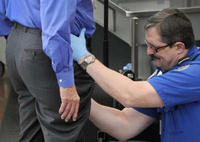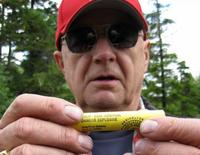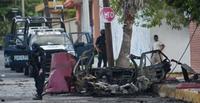-
Texas House prohibits intrusive airport pat downs

The Texas House of Representatives approved a bill that would make invasive pat downs at airports a crime; pat down procedures that would be covered under the measure are inspections that touch the anus, sexual organ, buttocks, or breast of another person including through the clothing, or touches the other person in a manner that would be offensive to a reasonable person; the law would not be enforceable since state legislatures have no authority over federal agencies such as the TSA
-
-
Infrared sensors could help police detect suicide vests
Sophisticated infrared sensors originally designed for the U.S. military could soon be used by local police departments to detect suicide bombers; Thermal Matrix USA initially designed its Access Counter IED Technology system to assist military personnel in Iraq and Afghanistan identify potential suicide bombers, but hopes to create a model that local law enforcement agencies can deploy; the company has modified its product to significantly reduce its size, weight, and deployment time to be more practical; the devices are capable of detecting any hidden objects including knives, guns, plastics, and even liquids
-
-
Remote bomb detection sensors
European scientists are embarking on a project to develop a network of state-of-the-art sensors capable of detecting hidden explosives; the sensors will work by detecting the chemical traces of explosive vapors in the air in order to provide early warning to security services and protect vulnerable urban populations from the threat of Improvised Explosive Devices (IEDs), often used by terrorist organizations
-
-
Researchers use bee venom to detect explosives
Using bee venom, researchers have developed new bomb detectors that are so sensitive they are capable of detecting a single molecule of an explosive; when chemical engineers at the Massachusetts Institute of Technology (MIT) coated carbon nanotubes in bombolitins, protein fragments found in bee venom, they discovered that these proteins reacted with nitro-aromatic compounds like TNT at the molecular level; current bomb detectors rely on spectrometry which analyzes charged particles as they move through the air, which makes them far less sensitive than the recently developed bee-based detectors
-
-
New 2-in-1 explosive detector and neutralizer
A two-in-one material that can both detect and neutralize explosives of the type favored by terrorists is unveiled; the material is made of metal oxide nanoparticles so small that 50,000 could fit across the width of a single human hair; it changes color in the presence of certain explosives, alerting emergency responders to the threat; it also can be sprayed onto bombs or suspicious packages to inactivate certain explosives
-
-
New sensor detects minute traces of explosives
MIT chemical engineers develop a new sensor that can detect minute traces of explosives; the new sensors would be more sensitive than existing explosives detectors — those commonly used at airports, for example — which use spectrometry to analyze charged particles as they move through the air
-
-
ATF cracks down on bombs used to scare seals

Much to the frustration of California fishermen, the U.S. Bureau of Alcohol, Tobacco, Firearms, and Explosives (ATF) is starting to regulate the firecrackers used to scare away seals from fishing lines; beginning 1 May, ATF officials will begin enforcing a federal law that mandates anyone who purchases the seal “bombs” to obtain a special permit and clear a background check in order to prevent terrorists or criminals from using them; the bombs resemble M-80 firecrackers and are shot from a gun; fishermen and farmers use them to scare away animals like hungry birds or seals
-
-
Dayton installs automated baggage screening system at airport

On 17 May Dayton International Airport in Ohio will begin using a sophisticated new automated baggage screening system that will save time and resources; using a series of machines, the new system will automatically screen luggage for explosives; any suspicious bags will be flagged and sent to security screeners for more careful examination; TSA officials hope that the new machines will help reduce check-in times for passengers, increase efficiency, and even minimize the number of screeners needed
-
-
Car-based IED attacks an emerging threat in Mexico

Intelligence analysts worry that Mexican drug cartels will increasingly turn to deadly car bombs in the escalating drug wars; drug cartels have already assassinated several government officials using improvised explosive devices (IEDs) planted in cars; in Mexico IEDs are easy to construct due to easy access to powerful commercial explosives that are widely used in the country’s mining and petroleum industry; due to strict gun laws, it is actually cheaper and easier to obtain explosives than guns; to defend against this emerging threat the U.S. consulate in Monterrey erected concrete barriers
-
-
Indian explosives detection technology comes to U.S.
A south Carolina-based company signs a memorandum of understanding with India’s Defense Research and Development Organization (DRDO) to enhance the DRDO-developed Explosives Detection Kit (EDK) so it meets standards that will allowed it to be used by the U.S. military and homeland security
-
-
Insider threats in Afghanistan increase need for explosive detectors
In Afghanistan suicide bombers are increasingly disguising themselves as friendly forces to successfully infiltrate secure allied bases and wreak havoc; April has been a deadly month for allied troops in Afghanistan with at least four attacks taking place where suicide bombers disguised themselves as police officers or members of the army; to protect against this threat, Thermal Matrix specializes in person-borne improvised explosive device (PBIED) detection devices; the firm has been working with the U.S military for the past several years to develop the Thermal Matrix ACT system which is capable of detecting suicide bombers from long distances; the system uses infrared imagery to analyze the heat signature of approaching individuals to determine if they are carrying any explosives
-
-
British company purchases American IED detection firm for $90M
Last week the British defense firm Chemring finalized a deal to purchase Detection Systems, a subsidiary of General Dynamics, for $90 million; North Carolina based Detection Systems specializes in improvised explosive devices (IED) sensor systems; Detection Systems currently supplies the U.S. military with vehicle mounted IED detectors; the acquisition helps to enhance Chemring’s existing IED detection capabilities and provides growth opportunities for its chemical and biological detection programs; the purchase will not be finalized until the U.S. government reviews the proposal
-
-
Space technology of practical uses on Earth

Terahertz technology developed for space missions to study the most distant objects in the universe is now finding a host of practical applications back on Earth; most clothing and packaging materials are transparent to Terahertz radiation, whereas skin, water, metal and a host of other interesting materials are not; this gives rise to some important day-to-day applications: detecting weapons concealed under clothing or inside parcels; distinguishing skin and breast cancer tissue; quality control of manufactures items and processes in factories
-
-
Trees as contamination detectors
Determining the presence and concentration of contaminants has been an invasive, laborious process; now a Missouri University of Science and Technology team has developed a faster, more economical method of determining such contamination at miniscule levels; the Army has funded additional research for explosive residue detection
-
-
Army seeks long distance explosive detection scanners for people
The U.S. Army is seeking to rapidly deploy long distance chemical detection devices that are capable of detecting explosives hidden on people; ideally, the devices will be able to sense the presence of explosives and chemicals on people standing, walking, or running from as far away as 100 yards; the Army wants to be able to field these capabilities within a year, so it is only considering mature technologies that are ready to be implemented; the request for proposals will close on 6 May
-
More headlines
The long view
Prototype Self-Service Screening System Unveiled
TSA and DHS S&T unveiled a prototype checkpoint technology, the self-service screening system, at Harry Reid International Airport (LAS) in Las Vegas, NV. The aim is to provide a near self-sufficient passenger screening process while enabling passengers to directly receive on-person alarm information and allow for the passenger self-resolution of those alarms.
